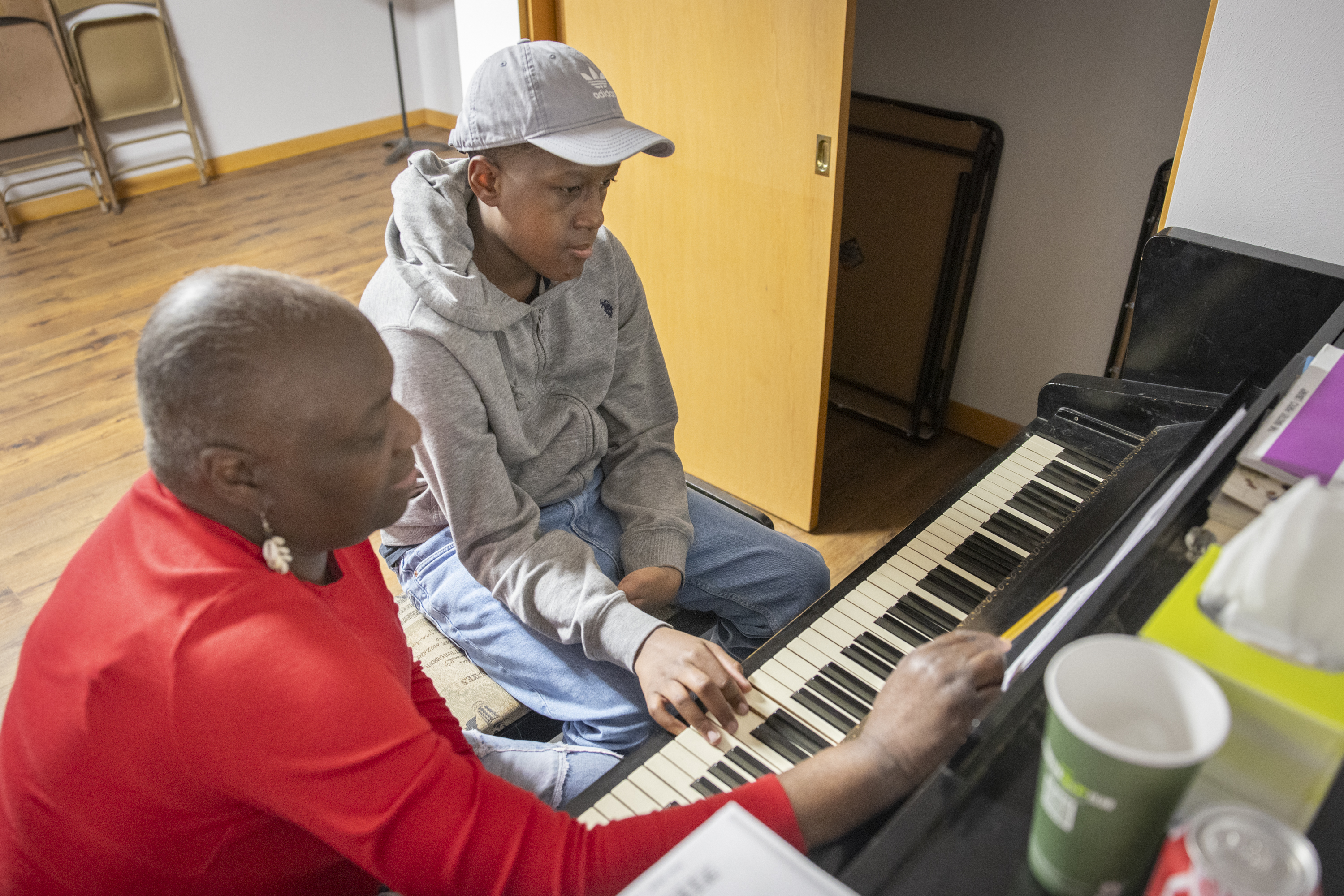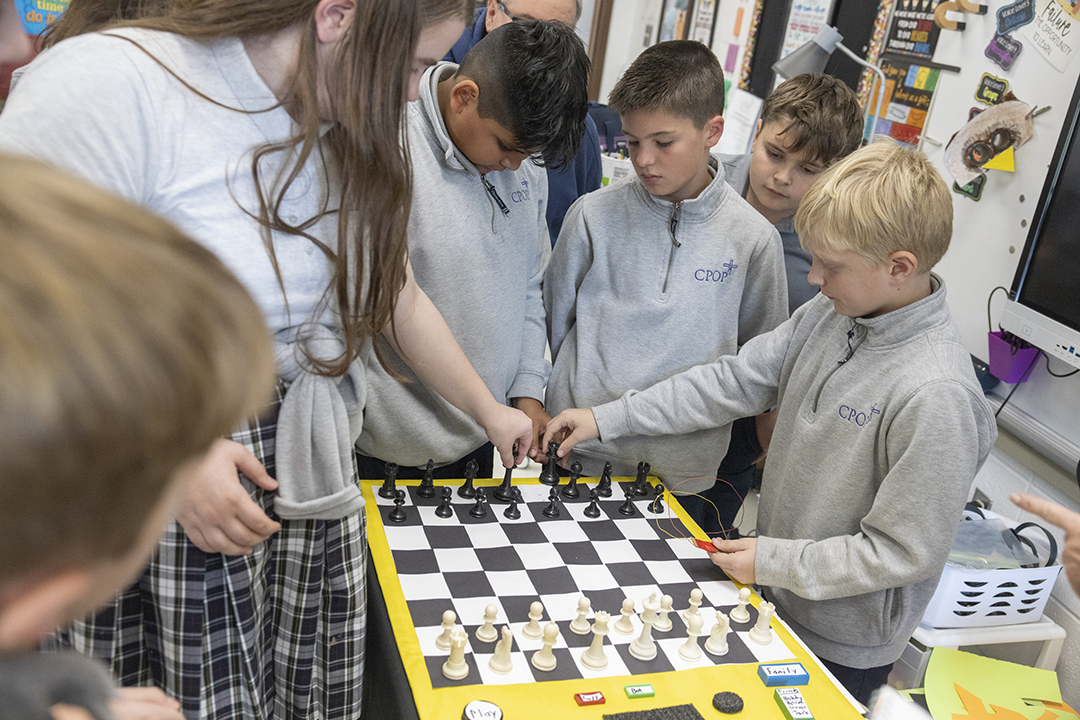Inclusive education for students with special needs rising in Catholic schools

Schools find creative solutions to educating students with diverse learning needs
Isabel Reinberg stood at a table with two of her classmates as they worked on a social studies slideshow project at Christ the King School in University City.
The fifth grader was tasked with coming up with several facts about one of the 13 original colonies, Massachusetts, and Isabel discovered that colonists went there because they sought religious freedom. As they took a pause from their group project, Isabel high-fived her classmates, Norah Fagan and Ali Booth, on their work.
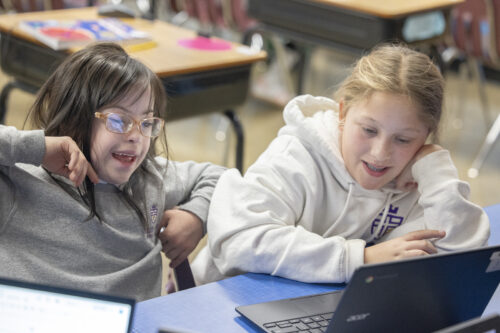
Katy Hugger, director of student services at Christ the King, oversees a steadily growing population of students with special needs. Among them is Isabel, one of three fifth graders with Down syndrome, along with a second grader with Down syndrome and several students with autism, ADHD or other learning disabilities.
Now in her fourth year at the school, Hugger arrived during a moment of transition. When she started, the number of students with diagnosed learning needs was small and included a support team with a learning consultant, instructional coach and resource teacher.
That allowed the school to respond more thoroughly to student needs, she said. Today, about 30% of students at Christ the King have a diagnosed learning disability and another 10% access resource support but don’t have an official diagnosis. The support team now includes additional resource teachers, paraprofessionals and seventh- and eighth-grade peer mentors.
“As we have had more students diagnosed, we have been able to tailor their needs into the classroom and curriculum, like small group testing, modifying curriculum or modified report cards,” Hugger said. “We’ve been blessed to look at the student and decide what the student needs and create that plan for them in that way, rather than looking at it as, this isn’t going to work in the classroom. We look at what can we do to best support that student and think outside the box.”
Christ the King is an example of a growing number of Catholic schools in the archdiocese that are accommodating students with special learning needs. Inclusive education, in which students with disabilities are integrated into general education classrooms with supports to learn alongside their peers, is a way of “ensuring that we’re living out a Catholic mission through honoring the dignity of a person and what it truly means to be pro-life and respecting the dignity of all human life,” said Kimberly Huelsing, who joined the archdiocesan Office of Catholic Education and Formation in July as director of special education and inclusion.

Growth of special education services
A survey of Catholic schools across the archdiocese last fall confirmed a growing demand for special education services and increased efforts to support students with diverse learning needs.
Eighty-four archdiocesan elementary and high schools surveyed in September 2024 reported that there were more than 3,000 students with at least one diagnosed learning or developmental need. (In October 2025, the archdiocesan Office of Catholic Education and Formation conducted its quarterly data collection with 118 Catholic schools and found that number now includes more than than 4,600 students.)
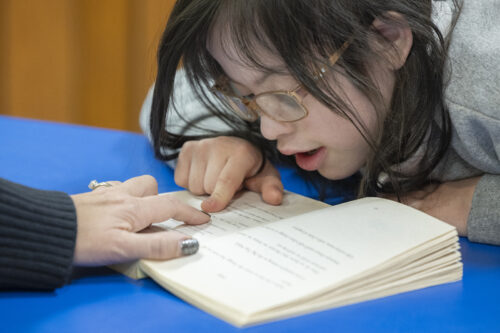
The majority of schools surveyed in 2024 also indicated prioritizing multi-tiered systems of support, and 76 percent reported having at least one staff member dedicated to student support or special education, reflecting a broadening interest in meeting the needs of students with disabilities.
In her role, Huelsing works with Catholic schools to educate them on the benefits of inclusion services, how to access already existing special education services, provide professional development and create and streamline guidelines and processes, among other needs.
The majority of Catholic schools have at least one learning consultant or similar staff person, Huelsing said. While the level of support can vary, “that has been a priority (for schools) to coordinate services and work with teachers,” she said. “We look at that as a model for building inclusion.”
Inclusive education is also one of the best ways “to educate students with disabilities, as long as we have a point person to support that student,” Huelsing said. “We are seeing trendwise in our country an increase in students with disabilities, especially with neurodiversities. If we don’t make a change and support them, we’re missing a very large part of our population.”
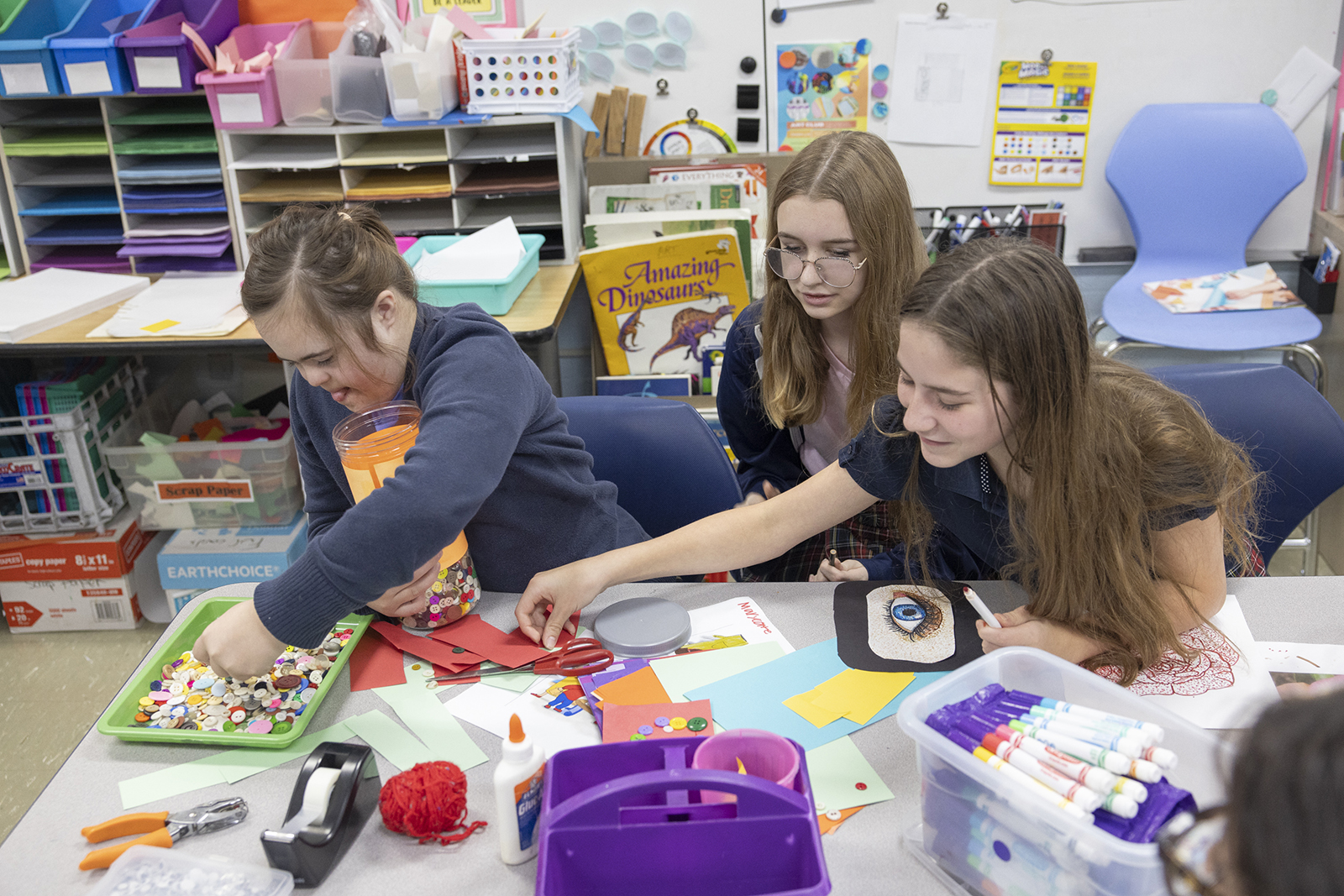
St. Gabriel School
A recent Friday was an early release day for students at St. Gabriel the Archangel School. Seated next to several classmates, Mary Cate Ryan busied herself in art class gluing buttons and googly eyes onto a piece of construction paper as she anticipated leaving at lunchtime for a treat at McDonald’s after school.
The seventh grader, who has Down syndrome, is one of several students with special needs who attend St. Gabriel. Her favorite class this year is religion, and she made her first Communion a year ago and now eagerly receives the Blessed Sacrament with her classmates at Mass.
Principal Tonya McEnery said the school community has long welcomed students with a wide range of learning needs — autism, dyslexia, sensory processing challenges, learning disabilities and physical disabilities such as spina bifida. When she arrived at St. Gabriel eight years ago after 25 years in public education, she brought with her an understanding and appreciation for special education services.
McEnery said she now feels blessed to apply that experience in a Catholic school setting. The school’s support team includes two learning consultants and one interventionist, supplemented by partnerships with outside providers. Some students receive additional support from private-pay therapists and St. Louis Public Schools, whose specialists come into the building to serve students directly. (A similar pilot program exists with Special School District of St. Louis County and more than a dozen Catholic schools.) The school also dedicates space for small-group occupational therapy sessions and collaborates with other organizations, such as One Classroom, for additional supports.
While the school had admitted students with special needs before McEnery’s arrival, she said their efforts have become more intentional, especially in supporting students with significant learning needs.
“Have we learned more over the years? Yes,” McEnery said. “I think we have a very concerted effort to ensure we’re providing more inclusive opportunities for our students. And that comes with training, with teachers collaborating, special ed staff, our (classroom) teachers and overall culture of the school.”
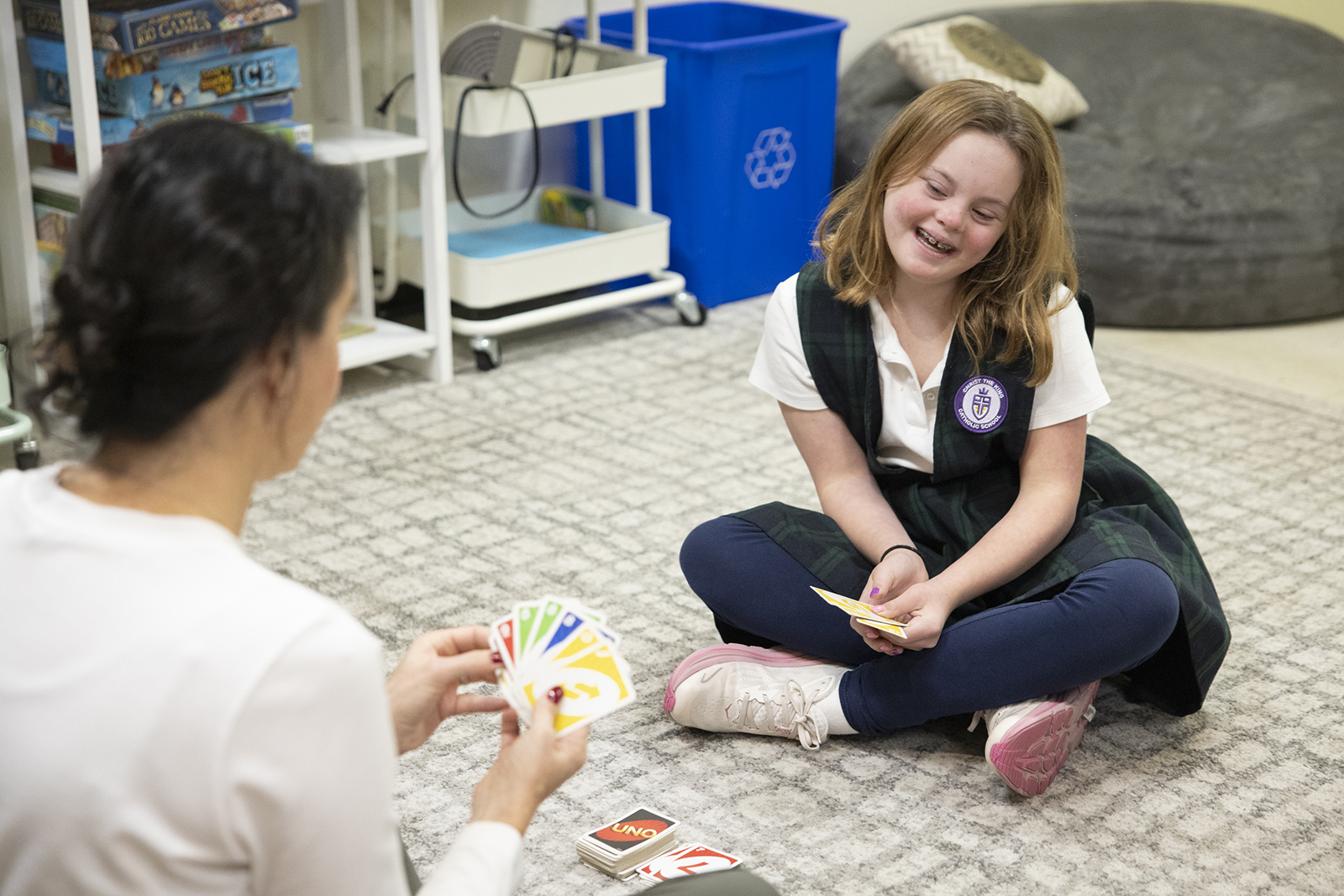
One Classroom
One Classroom’s drive to bring inclusive education to Catholic schools has grown in the past decade.
The nonprofit organization was started in 2015 to help fund inclusive education at Catholic schools for students with special needs. The program has since grown to include partnerships with 27 Catholic elementary schools and two high schools.
Beyond school grants, One Classroom also works with schools on professional development, parent and family support and advocacy. One of the greatest obstacles is working with schools to discover how inclusive education can be a possibility, executive director Kyle Van Frank said.
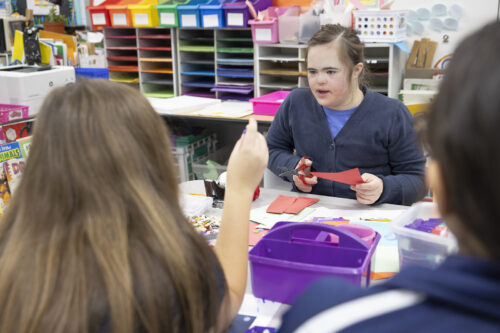
“The greater obstacle is a disposition to believe that this is a good and possible thing or the know-how to do it,” he said. Schools that have not adopted inclusive education practices are “saying no because they’re afraid of failing a child, letting down a family. That comes from a place of real kindness and love, but we want to be a resource to make sure that that’s a solvable problem.”
In addition to individualized support for inclusive education in schools, One Classroom provides ongoing professional development for educators. Van Frank said the goal is to make that training more accessible to educators in partner schools as well potential partner schools.
“I think right now the biggest sort of thing in our minds … is making sure that we’re not around for just another 10 (years) but for as long as schools need us,” he said. “We’ve been working with some schools for 10 years, and it’s saying, ‘If we’ve been funding the same thing for 10 years, can you start adopting some of these things into your budget and creating true financial sustainability?’ We want to be able to create a roadmap for schools to be able to do that.”
Special education at a glance
A survey was sent in September 2024 to 90 archdiocesan Catholic schools to determine the scope of special education services being offered. Eighty-four of those schools responded:
• More than 3,000 students have at least one diagnosis (a private or medical evaluation and/or public school evaluation). (An updated quarterly data collection from 118 Catholic elementary and high schools in October showed that number includes more than 4,600 students.)
• Almost 1,000 students (an average of 13 students per school) have educational eligibility for special education services through their local public school district.
• A majority of schools reported a desired focus on multi-tiered systems of support, a framework for supporting struggling learners in all areas.
• Seventy-six percent of schools reported they have at least one student support or special education staff member.
• Those staff members’ responsibilities were reported as:
Academic support: Assists students across subjects, provides accommodations and conducts remedial instruction
Special education coordination: Serves as a liaison with Special School District of St. Louis County for assessments, managing IEP updates and facilitating care team meetings
Student support and counseling: Provides emotional and behavioral support, manages care plans and conducts counseling sessions
Documentation and coordination: Maintains educational records, coordinates with parents and SSD and updates learning profiles
Testing and evaluation: Administers assessments, analyzes results and collaborates with teachers on student progress.
Schools find creative solutions to educating students with diverse learning needs
Subscribe to Read All St. Louis Review Stories
All readers receive 5 stories to read free per month. After that, readers will need to be logged in.
If you are currently receive the St. Louis Review at your home or office, please send your name and address (and subscriber id if you know it) to subscriptions@stlouisreview.com to get your login information.
If you are not currently a subscriber to the St. Louis Review, please contact subscriptions@stlouisreview.com for information on how to subscribe.




